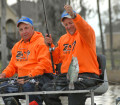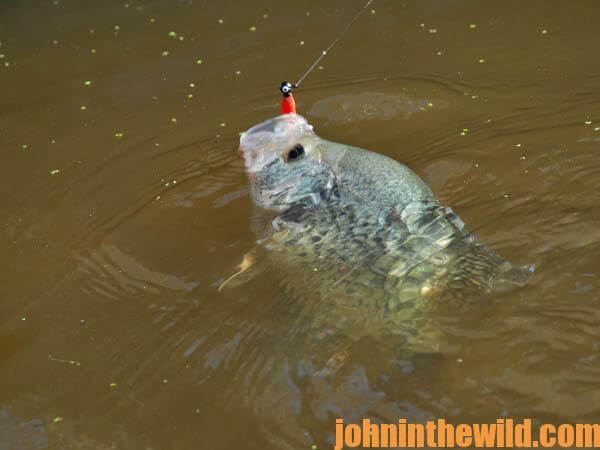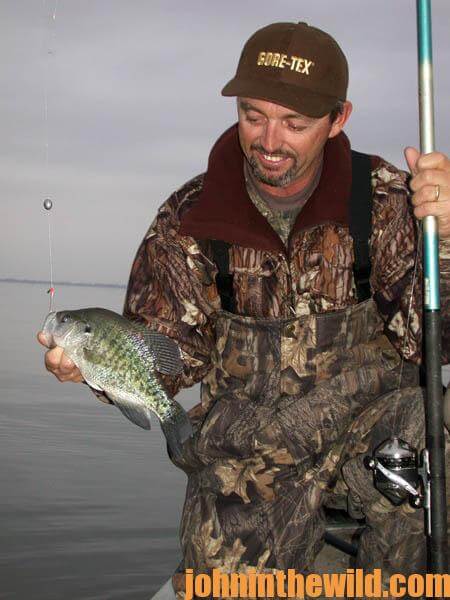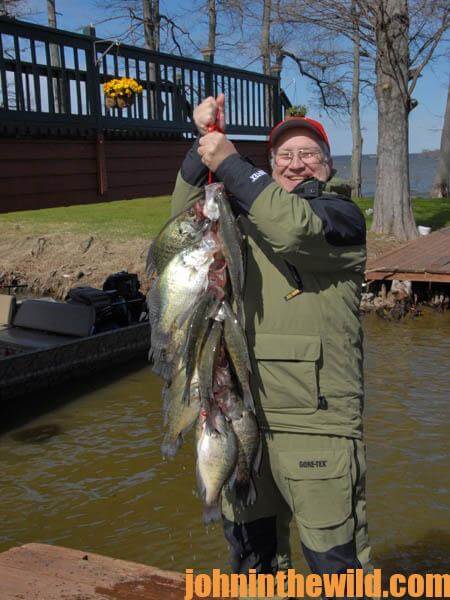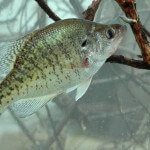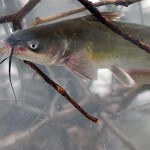John’s Note: February’s cool-weather crappie fishing can be highly productive with plenty of fast action and big fish. Or, it may be as slow as pouring maple syrup out of a cold pot on a frosty morning. What makes the difference is where you find the crappie. Let’s look at some ideal February crappie situations.
Crappie prefer to have structure they can get into like limbs, logs and brush.
The disadvantage to concrete fish attractors is they don’t provide have hiding places for crappie. However, some resourceful anglers have remedied this problem by sinking brush next to the concrete to further enhance the structure’s fish-attracting properties. Sinking the brush on the backside of the current is a must, so the concrete structure will break the current and keep the brush from being washed away.
Crappie position themselves on concrete structures at different depths at various times of the year. Either of two techniques can tell an angler at what depth the crappie are holding. Motor your boat along the edge of the concrete while reading your depth finder, which may allow you to see the crappie and determine at what depth they are staying. However, many times the crappie will be holding so close to the structure you won’t be able to spot them on a depth finder. But the problem associated with locating crappie by reading your depth finder while motoring your boat along the edge of the concrete is, if the fish are shallow, I believe they can be spooked by being run over with a boat. So, I start off by assuming that the crappie are holding shallow on the concrete.
If I’m jig fishing, I’ll anchor my boat upstream of a piling. I’ll cast downstream, letting my jig fall right next to the concrete piling. On each cast, I count my jig down and then begin to retrieve. The first cast and retrieve will be right below the surface of the water, because often on a bright, warm day – even in February – crappie may be only a foot or two under the surface. With each successive cast, I allow the jig to drop from 6-inches to 1-foot deeper than the cast before, retrieving it to the boat with a steady retrieve. When a fish strikes, I continue to fish that depth of water to try and take more slabs. Another important ingredient in taking concrete crappie is to keep the jig bumping the concrete as long as possible during the retrieve. Many times a papermouth will take the bait just as it leaves the end of a concrete structure. As long as your jigs are in contact with the concrete, you will catch more crappie than if the jigs are swimming in open water 2 or 3 inches from the concrete. Concrete crappie are not unlike fish found on other types of structure during February. They soon will wise-up to the color of the jig you’re throwing and quit biting. But by changing the color of the jig you’re throwing, when the crappie stop hitting the lure, often you can keep on taking crappie. Of course, some concrete crappie are fickle. You may cast every color of jig in your tackle box without the crappie taking the bait, until you find the exact color they want on that specific day. Sometimes that color may be an unusual color of grub like orange, pink or blue-and-white stripe. But once you discover the particular color the fish will hit, you may limit-out on fat slabs.
When fishing live bait, I’ve found that keeping the minnow in contact with the concrete will pay-off in more bites. Anchoring your boat out either a pole or a rod’s length from the structure may be the most-productive tactic. Setting your cork or fishing a tight line at various depths will allow the angler to determine at what depth the crappie are feeding. Once you start getting bites, then change all your lines, so the baits will be placed at the depth where the crappie seem to be holding. If there’s a current running, let your cork bump the concrete. Then the bait will be washed-down the side of the structure and into the eddy hole to trigger strikes. One of the best live bait fishermen I ever have angled with, Tom Adams, has a theory about live bait. “I believe on certain days crappie prefer one size of bait over another size. Although some days they want small minnows, on other days they like large minnows. I’ve learned that crappie become accustomed to feeding on the size of bait that’s the most prevalent on the structure where they’re holding. If most of the baitfish holding on the concrete structure are small, and the crappie are accustomed to eating that small bait, then perhaps the crappie will be more likely to take a small minnow than a big minnow. If the baitfish in that structure are large, and the crappie feed on the big baits, then an angler naturally can assume that larger minnows will produce more crappie in that area than smaller minnows will. But there’s no sure way of knowing until you start fishing.
“When I go out for a day of fishing, I carry a bucket of small minnows and a bucket of large minnows and experiment with both to see which size of bait the crappie prefer. If I catch more crappie on small minnows, then I only utilize small minnows, until I use-up all of the bait I have. When I run-out of small minnows, I will try to fish the large minnows. However, if I find that the crappie are turning down the larger bait, I leave the structure and return to the bait shop to buy more small minnows. I think that not giving the crappie the size of bait they prefer is a mistake many crappie fishermen make. My time is better spent by going back to the bait shop to purchase the size of minnows the fish are biting that day than to try to convince the crappie holding on the concrete structure to bite a bait bigger than what they want. This principle applies to larger minnows as well as small minnows. If the crappie prove they favor the bigger minnows, I don’t try to persuade the fish to take small minnows. After the fish tell me what bait they want to bite, I try to provide it.”
No matter how productive a concrete structure is, how well it is positioned, and how many crappie it is capable of holding, no structure – concrete or not – always will concentrate crappie at all times of the year under all weather and water conditions. All of us have fished bridge pilings one day and then not had a bite on that same concrete piece of structure on other days. However, then I’m out crappie fishing, I never pass-by a large piece of concrete in February and other cold weather that I don’t cast a jig to it or drop a minnow around it. When the weather is cool, and the crappie are hunting warm water, concrete structures are good places to look for hot slab action.
“Crappie: How to Catch Them Spring and Summer” contains information on all aspects of fishing for crappie and the best, most-productive tactics from anglers all across the country. Also, you can learn more about crappie fishing from the Reelfoot Lake pros by purchasing the eBook, “Reelfoot Lake: How to Fish for Crappie, Bass, Bluegills and Catfish & Hunt for Ducks” by John E. Phillips. “Click here to get these book.”
About the Author
John Phillips, winner of the 2012 Homer Circle Fishing Award for outstanding fishing writer by the American Sportfishing Association (AMA) and the Professional Outdoor Media Association (POMA), the 2008 Crossbow Communicator of the year and the 2007 Legendary Communicator chosen for induction into the National Fresh Water Hall of Fame, is a freelance writer (over 6,000 magazine articles for about 100 magazines and several thousand newspaper columns published), magazine editor, photographer for print media as well as industry catalogues (over 25,000 photos published), lecturer, outdoor consultant, marketing consultant, book author and daily internet content provider with an overview of the outdoors. Click here for more information and a list of all the books available from John E. Phillips.

